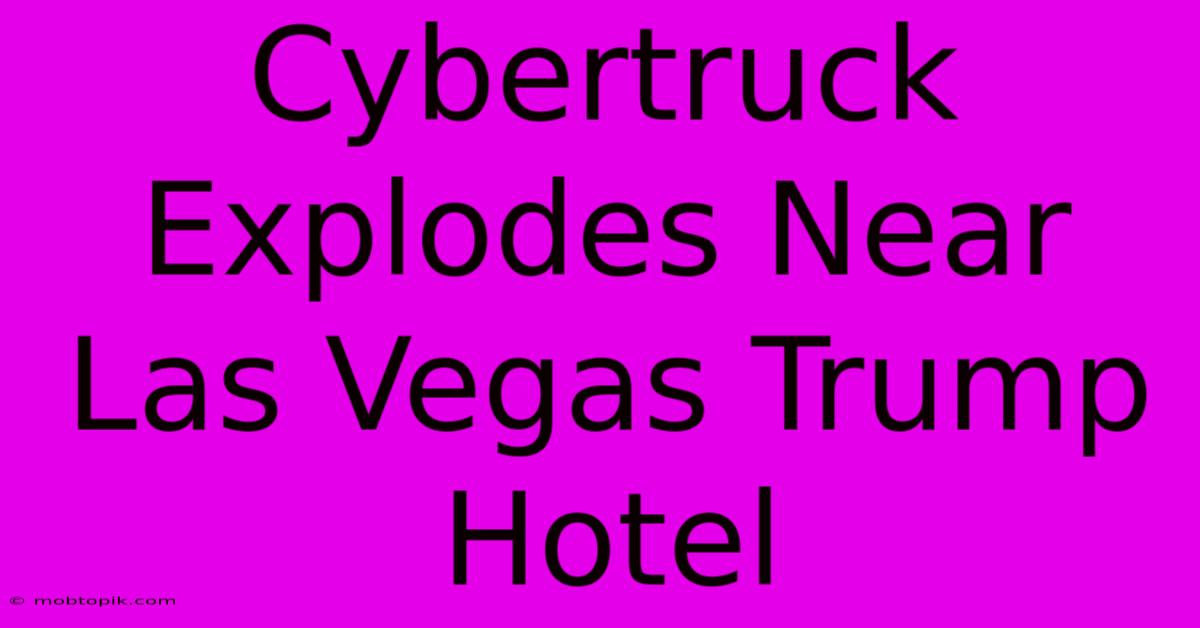Cybertruck Explodes Near Las Vegas Trump Hotel

Discover more detailed and exciting information on our website. Click the link below to start your adventure: Visit Best Website mobtopik.com. Don't miss out!
Table of Contents
Cybertruck Explodes Near Las Vegas Trump Hotel: A Detailed Look at the Incident and its Aftermath
The internet exploded – quite literally, in a way – with news of a Tesla Cybertruck explosion near the Las Vegas Trump Hotel. While initial reports were sensationalized and details scarce, this incident raises crucial questions about electric vehicle safety, the reliability of cutting-edge technology, and the potential consequences of such events in densely populated areas. Let's delve into the available information, analyze potential causes, and explore the broader implications.
The Incident: A Preliminary Overview
Reports surfaced on [Insert Date if Available, otherwise remove this sentence] detailing an apparent explosion involving a Tesla Cybertruck near the Las Vegas Trump Hotel. Social media was immediately flooded with images and videos, albeit many were blurry, unverified, or even fabricated. Initial eyewitness accounts varied wildly, ranging from a minor battery fire to a catastrophic explosion with significant structural damage to the vehicle. The lack of clear, consistent information fueled speculation and fueled online debate.
What We Know (and Don't Know):
- Location: The incident allegedly occurred near the Las Vegas Trump Hotel, placing it in a high-traffic, high-visibility area. This significantly increases the potential for injury and damage.
- Extent of Damage: The severity of the explosion remains unclear. Early reports ranged from minor to catastrophic, making definitive conclusions impossible without official statements.
- Cause: The root cause of the explosion is currently unknown. Potential factors range from battery malfunction to external factors like an accident or deliberate sabotage. A thorough investigation is needed to determine the precise cause.
- Injuries: Reports of injuries are inconclusive. The proximity to the hotel and the potential for flying debris make this a crucial aspect requiring clarification.
- Official Statements: As of this writing, [Insert date] there has been no official statement from Tesla, Las Vegas authorities, or other relevant entities confirming the details of the incident. This lack of official confirmation further complicates the situation and allows for rampant misinformation.
Potential Causes: Exploring the Possibilities
Several factors could have contributed to this alleged Cybertruck explosion. It’s crucial to remember that these are speculative possibilities until a full investigation is complete.
1. Battery Thermal Runaway:
Electric vehicle batteries are complex systems containing thousands of individual cells. A failure in a single cell can trigger a chain reaction, leading to a thermal runaway – a rapid increase in temperature that can result in fire or explosion. This is a known risk in electric vehicle technology, although manufacturers invest heavily in safety mechanisms to mitigate these risks. The Cybertruck's unique design and battery technology may be relevant here, although this requires further analysis.
2. External Factors:
The incident could have resulted from external factors unrelated to the Cybertruck itself. A collision, a short circuit caused by external damage, or even deliberate sabotage could have all triggered the explosion. The environment, including extreme heat or other environmental conditions, could also play a role.
3. Manufacturing Defects:
While less likely, manufacturing defects in the Cybertruck's battery pack or its electrical system could also be contributing factors. A thorough investigation by Tesla and relevant authorities will be crucial in determining if any manufacturing flaws played a role.
4. Software Glitches:
Although less probable, a software glitch in the vehicle's battery management system could potentially contribute to an unexpected thermal event. However, Tesla has a strong track record of software updates and safety protocols.
Implications and Future Considerations
Regardless of the ultimate cause, this alleged incident has significant implications.
1. Public Perception of Electric Vehicles:
Incidents like this, even if isolated, can negatively impact public perception of electric vehicles. Concerns about safety and reliability could influence consumer confidence, especially given the Cybertruck's highly publicized unconventional design.
2. Regulatory Scrutiny:
The incident might lead to increased regulatory scrutiny of electric vehicle safety standards and manufacturing processes. This could result in stricter regulations and more rigorous testing procedures for EV batteries and electrical systems.
3. Tesla's Response:
Tesla's response to this alleged incident will be crucial. A transparent and thorough investigation, coupled with effective communication with the public, will be essential in mitigating negative publicity and maintaining consumer trust. A lack of response or an attempt to downplay the event could significantly damage the company's reputation.
4. Insurance Implications:
The incident raises questions about insurance coverage for such events. Determining liability and ensuring adequate compensation for any damages or injuries will be complex.
Conclusion: Awaiting Official Information
Until official investigations are complete and details are released, much of the information surrounding the alleged Cybertruck explosion near the Las Vegas Trump Hotel remains speculation. However, the potential implications are significant, highlighting the need for robust safety measures in electric vehicle design, manufacturing, and operation. The incident underscores the importance of transparency and thorough investigation in maintaining public trust and ensuring the safe integration of electric vehicles into our society. We must await official statements from relevant authorities and Tesla before drawing definitive conclusions. The focus should remain on ensuring the safety of electric vehicle technology and preventing similar incidents in the future.

Thank you for visiting our website wich cover about Cybertruck Explodes Near Las Vegas Trump Hotel. We hope the information provided has been useful to you. Feel free to contact us if you have any questions or need further assistance. See you next time and dont miss to bookmark.
Also read the following articles
| Article Title | Date |
|---|---|
| City New Years Day Match Highlights | Jan 02, 2025 |
| Tesla Fire Exploding Mortars Inside | Jan 02, 2025 |
| Ano Nuevo El Giro En La Vida De Arly | Jan 02, 2025 |
| Illness Didnt Stop Skattebos Mvp | Jan 02, 2025 |
| Arizona State Outperforms Skattebos Efforts | Jan 02, 2025 |
